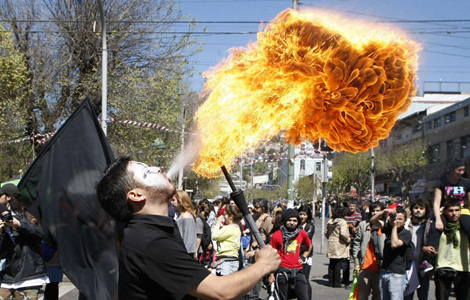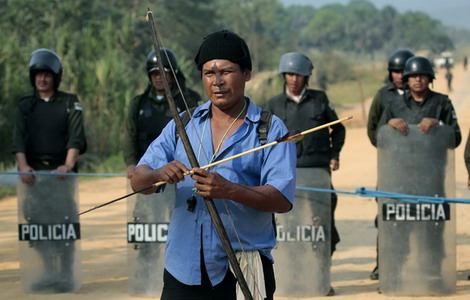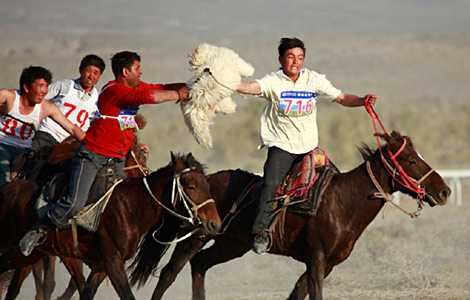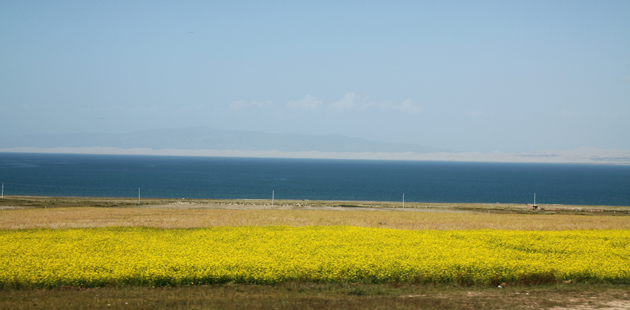Devastated ecosystems, modernization force herdsmen out
Updated: 2011-09-23 21:32
(Xinhua)
|
|||||||||||
ALXA - Camel herder Oqir has been hoping for rain for a long time, but a downpour has yet to fall in the Alxa Desert located in Northern China's Inner Mongolia autonomous region.
"I can't remember the last time it rained. If the drought continues, the camels won't make it through to next spring," he said, crouching down in the endless desert, frowning at his herd of gaunt camels.
Oqir has about 100 camels that he depends on for the majority of his annual income. A healthy camel can bring him 4,000 yuan ($625) to 8,000 yuan at a market.
Unfortunately, nobody wants to buy his weak and emaciated camels.
"Herdsmen will quit pasturing sooner or later, and move to the cities where the Internet and dancing halls are accessible means of killing loneliness and desperation," Oqir said, adding that the idea of living in a city excites him.
Deteriorating ecosystems and modernization have negatively impacted traditional herding techniques and ways of life for herders, posing great challenges for many herdsmen like Oqir.
E. Paolede, head of the China Federation of Literary and Art Circles(CFLAC) in Alxa Left Banner, says galloping through grasslands on a camel's back is his most lasting memory.
"That was amazing, but the grassland is degenerating and the yurts are vanishing nowadays," he said.
Inner Mongolia's grasslands, which rank among China's five largest prairies, have shrunk to around 1 billion mu (about 667 million hectares), a 10 percent contraction since the 1950s.
To hamper the trend of shrinking grasslands, China's government has kicked off its largest protection subsidy project ever, allocating nearly 7 billion yuan for herders whose grazing lands have decreased since 2000.
"Government support may be the only possible way for the grassland's sustainable development" Oqir said.
Oqir owns more than 70,000 mu of grasslands, 94 percent of which have allowed limited grazing since 2006.
As a result of a policy limiting grazing, some herders quit herding and started businesses, according to Oqir.
Alanteng Qiqige and her husband Sechen Batu left their home in the grasslands for a neighboring highway to make a living peddling stones after herding was banned in some areas.
But Alanteng said she prefers the nomadic life of pasturing, even though selling stones can generate the same income.
Operating a business may bring greater earnings, but "without pasturing, parts of traditional culture, like the long song or throat singing, will no longer exist," said E. Paolede.
"Long song is the singing that can be only sung on horseback, you can't perform it inside an office building," he said.
Long song is a traditional form of Mongolian music, rooted in nomadic culture and regional characteristics. In 2005, UNESCO declared it one of the Masterpieces of the Oral and Intangible Heritage of Humanity.
Meanwhile, UNESCO put throat singing, a particular variant of overtone singing, on its list of World Intangible Heritage in 2009.
CFLAC in Alxa Left Banner, led by Paolede, has held folk craft contests to raise awareness of the need to protect folk arts. Awareness campaigns featuring Mongolian wrestling and traditional dance training were conducted in cooperation with other departments, as well.
Measures taken by the central government to protect traditional Mongolian culture have also been enhanced.
"Mongolian culture should be passed down well for it is a great component of traditional Chinese culture. We should not allow it to vanish," said E. Paolede.
Hot Topics
Organ transplant bonds mother and son
Editor's Picks

|

|

|

|

|

|







